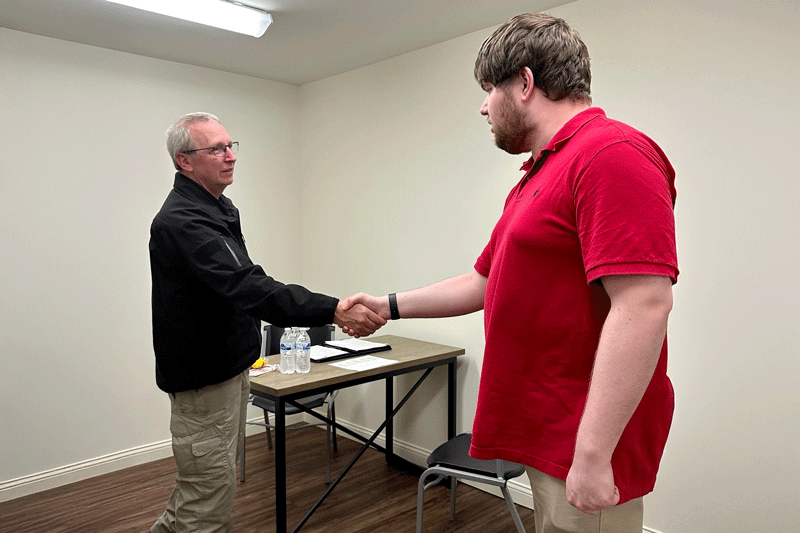Effective communication is essential for workplace success. For autistic young adults seeking employment, understanding and adapting unique communication styles can help create more successful outcomes.

Ronnie Ward from the Bowling Green Police Department meets LifeWorks 2024 graduate Noah Thomas for a mock interview to practice interview skills and help Noah become more comfortable sharing about himself and the type of work he likes to do.
Being on the autism spectrum doesn’t mean that you can’t have a meaningful and productive employment experience. In my role helping prepare and place autistic young adults in various businesses and industries, I’ve seen employers realize that these individuals are a welcome addition to their workplace. Autistic young adults form a dedicated workforce known for their dependability, punctuality, and earnestness. They can excel at all types of roles.
While part of my focus is working with employers to develop their autism-readiness skills and aiding in the transition of incorporating a diverse workforce, I also work individually with participants in a vocational program to prepare for successful and meaningful employment. Here are some practical tips to ensure successful workplace communication as you prepare for employment and once you’ve landed the job.
Job Shadowing
An effective strategy for becoming employment-ready is to participate in a job shadowing program, where you can experience a role and understand communication expectations. For example, one young person that we worked with thrived during a job-shadow opportunity at a local conference center as a laundry attendant. The position was single-focus and task-oriented. However, because of the nature of the work, another participant found the role more challenging because of the multiple conversations occurring with other staff in the room. She found a better fit while job shadowing a lobby attendant, engaging in one-on-one conversations with guests while managing specific lobby tasks. For both participants, this hands-on experience was a crucial part of understanding the workplace communication styles each role required and where they were better suited.
Mock Interviews
Participating in a mock interview is a valuable tool in preparing for job interviews and workplace interactions. Mock interviews to hone your skills and learn to be comfortable sharing about yourself and the types of work you like to do. Look for local community centers, autism support organizations, or vocational development services that offer mock interview sessions. Alternatively, you can ask friends, family, or professionals in your network to practice interviews with you. We have developed a system for facilitating these interview sessions, complete with templates, guiding questions, and a process for getting volunteers in the mix without the need for extensive training.
Inform Your Employer
Individuals on the autism spectrum tend to be very literal in their communication. It’s important to let your workplace know this so they can also communicate with very specific instructions to avoid misunderstandings. For example, an employer who asks, “Do you want to run this report for me?” might receive a very direct “no.” But “Please run this report for me” is a clear and specific request. This approach reduces ambiguity and ensures clear expectations.
Additionally, let your employer know that information from you may sometimes come out differently than someone who is neurotypical. Encourage the employer not to make assumptions about their meaning and to check with you if they are unsure about what you meant. You can also share published guides on how to communicate with you more effectively.
Addressing Sensory Issues
Sensory issues are common among autistic individuals. If you require accommodation, don’t hesitate to ask for support. The Americans with Disabilities Act ensures that workers who require an accommodation have equal access in the workplace. There may be a local program in your community that can help provide funding for accommodations. For instance, in my community, the Office of Vocational Rehabilitation has been able to provide funding for noise-canceling headphones as assistive technology in the workplace.
Clarify Preferences
Talk with your workplace about their communication preferences and agree ahead of time on how to proceed. For example, discuss the best way to receive instructions (in writing or over the phone), when the best time to communicate with you is (when you first get to work or after your break), and more. Ask them to be very specific with their request. For instance, instead of saying, “Could you get this done when you have a moment?” ask them to be more specific by saying, “Please complete this by 3 p.m.”
Workplace Etiquette
Some workplace environments encourage small talk before meetings, asking about weekends, etc. Others don’t. Ask your employer to share workplace-specific etiquette with you. This information will provide clarity about expectations.
Practicing Nonverbal Cues
Nonverbal communication, such as eye contact, body language, and facial expressions, can enhance your interactions with colleagues. But it takes practice. Try role-playing with friends or family so you can get more comfortable with these types of interactions. Join a social skills group with others who also want to learn nonverbal communication. It is important to recognize nonverbal cues without feeling the pressure to conform to social expectations. Masking can be stressful and exhausting, which may not lead to successful outcomes.
Seek Consistent Feedback
Regular check-ins and feedback sessions with your employer to clarify expectations and expected progress will provide valuable insights into your communication skills and areas for growth. Be open to the feedback and suggestions. Accepting feedback also takes practice. This is another skill you can practice with friends and loved ones. Becoming defensive or frustrated when employers give constructive feedback does not make a good impression.
Use Written Communication
Written communication can help clarify messages and reduce misunderstandings. Ask your employer to provide written instructions when possible so you can refer back to the information as needed. This could be as simple as what time to be at work and when you can break for lunch to get more specific instructions on how to proceed on a certain project. The more specific and precise the instruction is, the easier it will be to understand and follow.
Understand Social Norms
Learning to make small talk, understanding conversational cues nonverbal cues, and recognizing when others are ready to end a conversation can enhance social interactions at work. Practice this with your peers. Volunteering in the community is a great way to practice and build confidence in social interactions.
While employers who create a supportive environment that allows autistic individuals to succeed is crucial, utilizing these practical steps will enhance communication in the workplace. With the proper strategies and support, you can thrive in a career and contribute meaningfully to the organization.
Kellye McIntyre, MSW, is the Director of Vocational Services for Lifeworks for Autism, a living and learning community for autistic young adults as they transition to independent living and employment in Bowling Green, Kentucky.
References
Grandin, T., & Panek, R. (2013). The Autistic Brain: Thinking Across the Spectrum. Houghton Mifflin Harcourt.
National Institute of Mental Health. (2021). Autism Spectrum Disorder. Retrieved from NIMH.
Patton, E. (2019). Autism, attributions, and accommodations: Overcoming barriers and integrating a neurodiverse workforce.
Silberman, S. (2015). NeuroTribes: The Legacy of Autism and the Future of Neurodiversity. Avery.
Vogus, T. J., & Taylor, J. L. (2018). Flipping the script: Bringing an organizational perspective to the study of autism at work.






